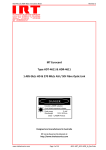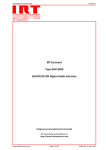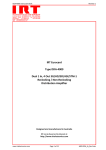Download DDT-4691 & DDR-4691 User Manual (Revision 00)
Transcript
DDT-4691 & DDR-4691 ASI / SD-SDI 8 Channel Mux Fibre Optic Link User Manual IRT Electronics Pty Ltd | www.irtelectronics.com Revision 00 DDT-4691 & DDR-4691 ASI / SD-SDI 8 Channel Mux Fibre Optic Link Revision History: Revision 00 Date 03/06/2014 By AL Change Description Applicable to: Units fitted with firmware version ≥ F2V0 & software version ≥ S1V1 Original Issue. IRT Electronics Pty Ltd | www.irtelectronics.com Page 2 of 18 Revision 00 DDT-4691 & DDR-4691 USER MANUAL Table of Contents: Section Page Revision History Operational Safety General Description Technical Specifications Configuration User DIP switch settings Installation Signal Connections Fibre Optic Connection Alarm Outputs DDT-4691 DDR-4691 Front and rear layouts Operation Figure 1: Attenuation versus wavelength SNMP – What Is It? DDT-4691 & DDR-4691 SNMP Functions DDT-4691 DDR-4691 Maintenance & Storage Warranty & Service 2 4 5 6 7 7 8 8 8 9 9 9 10 11 11 12 14 14 16 18 18 This instruction book applies to firmware versions ≥ F2V0, and software versions ≥ S1V1. IRT Electronics Pty Ltd | www.irtelectronics.com Page 3 of 18 Revision 00 DDT-4691 & DDR-4691 OPERATIONAL SAFETY WARNING Operation of electronic equipment involves the use of voltages and currents that may be dangerous to human life. Note that under certain conditions dangerous potentials may exist in some circuits when power controls are in the OFF position. Maintenance personnel should observe all safety regulations. Do not make any adjustments inside equipment with power ON unless proper precautions are observed. All internal adjustments should only be made by suitably qualified personnel. All operational adjustments are available externally without the need for removing covers or use of extender cards. Optical Safety The light emitted from the LASER diode used in this system is invisible and may be harmful to the human eye. Avoid looking directly into the fibre optic cable or connectors or into the collimated beam along their axis when the device is in operation. Operating the LASER diode outside of its maximum ratings may cause device failure or a safety hazard. DANGER Invisible LASER radiationAvoid direct exposure to beam Peak power Wavelength 2 mW 1270–1610nm Class 1 LASER Product IRT Electronics Pty Ltd | www.irtelectronics.com Page 4 of 18 Revision 00 DDT-4691 & DDR-4691 GENERAL DESCRIPTION BLOCK DIAGRAM DDT-4691 & DDR-4691 SIGNAL PATH DDT-4691 Any 8 x 270Mb/s ±100ppm (ASI or SDI) I/P 1 I/P 2 I/P 3 I/P 4 I/P 5 I/P 6 I/P 7 I/P 8 DDR-4691 O/P 1 O/P 2 O/P 3 Fibre O/P 4 Fibre I/P O/P O/P 5 Fibre Link 9-27dB optical path loss O/P 6 O/P 7 O/P 8 SNMP Any 8 x 270Mb/s ±100ppm (ASI or SDI) SNMP The DDT-4691 accepts up to eight 270 Mb/s input signals which may be ASI, SDI or a mixture of each type. The signals need not be phase or frequency synchronous. The signals are multiplexed into a single 2.97 Gb/s stream and transmitted optically via a single mode fibre. The DDR-4691 receiver performs the reverse operation and restores correct 270 Mb/s timing. The DDT-4691/DDR-4691 system is primarily designed for use with a 9/125μm single mode fibre and will allow an optical path loss up to 27dB. The DDT-4691 transmitter comes standard with a 1310nm DFB laser. Other CWDM wavelengths are available. The DDR-4691 receiver comes standard with an APD detector. SNMP (Simple Network Management Protocol) is available for monitoring and control when used in an IRT frame fitted with SNMP capability. Channels can be individually enabled or disabled via SNMP. The modules are designed to fit IRT’s standard Eurocard frames as well as IRT’s 4000 series frame for use with IRT’s SNMP system and may be used alongside any other of IRT’s analogue or digital Eurocards. Standard features: • 270 Mb/s type signals, such as ASI and SDI, capability. • Automatic cable equalisation for up to 300m on each input. • Optical path loss ≥ 27dB. • External urgent and non-urgent alarms for system monitoring. • SNMP monitoring module built in. Applications: • Multichannel digital on a single fibre. • Upgrade capacity of existing fibre. • Maintain timing between related signals by ensuring same path transmission delay. IRT Electronics Pty Ltd | www.irtelectronics.com Page 5 of 18 Revision 00 DDT-4691 & DDR-4691 TECHNICAL SPECIFICATIONS DDT-4691: Inputs: Type Equalisation Connectors 8 x independent ASI or SDI. Automatic for up to 300 m of Belden 8281 or equivalent cable. BNC 75Ω. Outputs: Type 1 x 2.97 Gb/s optical. Alarms: Major Minor O/C relay for loss of power, or LASER fail. O/C relay if no channels are present. DDR-4691: Inputs: Type 1 x 2.97 Gb/s optical. Outputs: Type Connectors 8 x independent ASI or SDI. BNC 75Ω. Alarms: Major Minor O/C relay for loss of power, or optical input fail. O/C relay if no channels are present Optical: DDT-4691 optical output DDR-4691 optical input Available wavelengths Optical fibre Optical connectors 0 dBm +4.5/-0 dB CWDM DFB laser. APD detector (standard), -9 to -27 dBm input level. CWDM DFB laser - 1270nm, 1290nm, 1310nm (standard), 1330nm, 1350nm, 1410nm, 1430nm, 1450nm, 1470nm, 1490nm, 1510nm, 1530nm, 1550nm, 1570nm, 1590nm & 1610nm. 9 to 27 dB APD detector (standard), or 3 to 18 dB PIN detector. Designed for use with 9/125 μm single mode fibre. SC/PC (standard). Power requirement: Voltage Consumption 28 Vac CT (14-0-14) or ±16 Vdc. DDT-4691 < 6.5 VA, DDR-4691 < 6 VA. 1 Optical path loss Other: Temperature range Mechanical Finish: Front panel Rear assembly Dimensions Note: 1 0 - 50° C ambient Suitable for mounting in IRT 19" rack chassis with all connections at the rear. Grey background, black lettering & red IRT logo. Detachable silk-screened PCB with direct mount connectors to Eurocard and external signals. 6 HP x 3 U x 220 mm IRT Eurocard. Optical attenuator supplied for DDR-4691 when optical path loss is less than 9dB. Due to our policy of continuing development, these specifications are subject to change without notice. IRT Electronics Pty Ltd | www.irtelectronics.com Page 6 of 18 Revision 00 DDT-4691 & DDR-4691 CONFIGURATION User DIP switch settings: SW1 ON DIP 1 2 3 4 5 6 7 8 DDT-4691: SW1-1 Not Used. SW1-2 Not Used. SW1-3 Not Used. SW1-4 Not Used. SW1-5 Not Used. SW1-6 Not Used. SW1-7 OFF ON SNMP Control – Can disable individual channels. DIP Switch Control – All channels are enabled (unless locked via SNMP). SW1-8 OFF ON Enable Major and Minor SNMP alarms to the frame Agent (CDM card) . 2 Disable Major and Minor SNMP alarms to the frame Agent (CDM card) . 2 DDR-4691: SW1-1 Not Used. SW1-2 Not Used. SW1-3 Not Used. SW1-4 Not Used. SW1-5 Not Used. SW1-6 Not Used. SW1-7 OFF ON SNMP Control – settings can be made via SNMP. DIP Switch Control – can be interrogated via SNMP, but SNMP settings are not functional. Note: all channels are enabled (unless locked via SNMP). SW1-8 OFF ON Enable Major and Minor SNMP alarms to the frame Agent (CDM card) . 2 Disable Major and Minor SNMP alarms to the frame Agent (CDM card) . 2 NOTE: 2 When using TRAPS via SNMP, depending on how system is set up, in order to avoid double reporting of alarms via the DDT-4691 or DDR-4691 itself and the CDM card (SNMP Agent) of the frame, Major and Minor SNMP alarms that are reported to the CDM card of the frame can be disabled. IRT Electronics Pty Ltd | www.irtelectronics.com Page 7 of 18 Revision 00 DDT-4691 & DDR-4691 INSTALLATION Pre-installation: Handling: This equipment may contain or be connected to static sensitive devices and proper static free handling precautions should be observed. Where individual circuit cards are stored, they should be placed in antistatic bags. Proper antistatic procedures should be followed when inserting or removing cards from these bags. Power: AC mains supply: Ensure that operating voltage of unit and local supply voltage match and that correct rating fuse is installed for local supply. DC supply: Ensure that the correct polarity is observed and that DC supply voltage is maintained within the operating range specified. Earthing: The earth path is dependent on the type of frame selected. In every case particular care should be taken to ensure that the frame is connected to earth for safety reasons. See frame manual for details. Signal earth: For safety reasons a connection is made between signal earth and chassis earth. No attempt should be made to break this connection. Installation in frame or chassis: See details in separate manual for selected frame type. Signal Connections: Up to eight 270Mb/s type of signals, such as ASI, SD-SDI, or a combination of both, are fed into 75 Ω BNC connectors on the rear connector panel of the DDT-4691. Unused inputs are best terminated with a 75 Ω termination to avoid spurious noise being sent to the receiver where the front panel LEDs could illuminate and give the false impression that there is a signal on that line. The corresponding outputs are by 75 Ω BNC connectors on the DDR-4691 rear connector panel. Output numbers on the DDR-4691 correspond to the input numbers on the DDT-4691. There is no need to terminate the unused channel outputs on the DDR-4691. Fibre Optic Connection: Optical connections are made to the panel adapter mounted on a bracket at the rear of the modules. Care must be taken to provide a clean surface on the optical connectors and in inserting the plug on the external fibre to prevent damage to the alignment ferrule of the panel adapter. The standard optical connector type is SC/PC and the type of fibre used must be single mode type. Note that for path lengths ≤ 9 dB for APD detectors, or ≤ 3 dB for PIN detectors, an optical attenuator must be used to avoid over driving the DDR-4691 detector. IRT Electronics Pty Ltd | www.irtelectronics.com Page 8 of 18 Revision 00 DDT-4691 & DDR-4691 Alarm Outputs: The external alarm contact connections are made to the 4 pin phoenix style connector on the rear assembly. On an alarm condition relay contacts go open circuit, that is switch open with respect to ground. The connections being: 1 GND. 2 GND. 3 Major Alarm. 4 Minor Alarm. The alarms reported are designated as either Major or Minor. DDT-4691: A Major alarm is designated as a laser fail alarm. A Minor alarm is designated if no inputs are present. DDR-4691: A Major alarm is designated as an optical input fail to the detector. A Minor alarm is designated if no channels are present; OR the optic input level has been deemed to be approaching , 3 or has gone below, its threshold limit . NOTE: 3 This is reported as an ‘opticalLow’ condition via SNMP. Note that if a received electrical signal is present in this situation, it may be possible that the signal may contain errors if the optical signal level has actually gone below its minimum reliable input level before the output is muted, whence an ‘opticalFail’ situation would be reported. Therefore accuracy of the received electrical signal should be confirmed if a Minor alarm, or opticalLow, condition is reported by the DDR-4691. IRT Electronics Pty Ltd | www.irtelectronics.com Page 9 of 18 Revision 00 DDT-4691 & DDR-4691 Front & rear panel connector diagrams: D D T -4 6 91 D D R -4 6 91 CH 1 CH 2 CH 1 CH 2 CH 3 CH 4 CH 3 CH 4 CH 5 CH 6 CH 5 CH 6 CH 7 CH 8 CH 7 CH 8 LASER FAIL INPUT DC DC N140 N140 IRT Electronics Pty Ltd | www.irtelectronics.com Page 10 of 18 Revision 00 DDT-4691 & DDR-4691 OPERATION The DDT-4691 is an 8 channel 270Mb/s multiplexer suitable for signal types ASI or SD-SDI (or a combination of both) that are electrically combined together and then converted to optical format for transmission down a single mode optical fibre. The DDR-4691 does the reverse where the 8 channels are de-multiplexed back into their original signals. The outputs OUT1 to OUT8 of the DDR-4691 correspond to the inputs IN1 to IN8 of the DDT-4691. If required, individual channels of both the DDT-4691 and DDR-4691 can be enabled or disabled via SNMP. Provided the SNMP ‘ctrlMode’ setting hasn’t been set to ‘lockToRemoteSNMP’, DIP switch SW1-7 = ON over-rides the ability to disable individual channels. If however the ‘ctrlMode’ has been set to ‘lockToRemoteSNMP’, DIP switch SW17 = ON has no effect. When a channel has been disabled, if a valid input is present, the corresponding channel’s front panel LED will flash to give a visual indication that that particular channel has been disabled. ON the DDT-4691 the disabled channels will not be sent with the other multiplexed inputs. Consequently the corresponding channel’s LED on the DDR-4691 will not illuminate as it has not received a signal on that channel. It is also possible to disable the output channels on the DDR-4691 muting the corresponding BNC output. Likewise the muted channel’s LED will flash if a received signal is present within the received optical signal. Should no inputs be present on the DDT-4691 card, an optical signal is still transmitted as an empty carrier signal, so the receiver will still receive an optical input. Single mode optical cable is directly connected to the modules at the rear. The standard optical connector type is SC/PC. CH1 CH2 CH3 CH4 CH5 CH6 CH7 CH8 LASER FAIL CH1 CH2 CH3 CH4 CH5 CH6 CH7 CH8 INPUT The system will operate with an optical path loss from 9dB to a maximum of 27dB when fitted with an APD detector (standard), and from 3dB to a maximum of 18dB when fitted with a PIN detector. An orange LED ‘INPUT’ indicator on the front panel of the DDR-4691, and a relay alarm accessible by the rear assembly, indicates when the optical path loss is approaching, or has exceeded, the maximum allowed. For path lengths <9dB optical loss when using an APD detector, or <3dB optical loss when using a PIN detector, an optical attenuator is required. The length of fibre that this corresponds to depends on the fibre loss characteristics at the relevant wavelength of the laser module chosen. Attenuation (dB/km) 10 950 1240 1380 1 IR absorption Rayleigh scattering 1/λ4 0.1 800 1000 1200 1400 Wavelength (nm) 1600 Figure 1: Attenuation versus wavelength. Attenuation in the fibre is due to Absorption and Scattering. IRT Electronics Pty Ltd | www.irtelectronics.com Page 11 of 18 Revision 00 DDT-4691 & DDR-4691 SNMP What Is It? SNMP stands for Simple Network Management Protocol. It is an application layer protocol for managing IP (Internet Protocol) based systems. SNMP enables system administrators to manage system performance, and to find and solve system problems. SNMP runs over UDP (User Datagram Protocol), which in turn runs over IP. Three types of SNMP exist: SNMP version 1 (SNMPv1), SNMP version 2 (SNMPv2) and SNMP version 3 (SNMPv3). It is not the intention here to discuss the differences between various versions, only to bring attention to the fact that IRT Electronics modules, fitted with SNMP capability, use SNMPv1. An SNMP managed network consists of three key components: Network Management Systems (NMS), agents, and managed devices. An NMS is the console through which the network administrator performs network management functions, such as monitoring status (e.g. alarm states) and remote controlling, of a set of managed devices. One or more NMS’s must exist on any managed network. Generally the NMS is a computer running third party SNMP control software. There are a number of third party SNMP software applications currently available on the market. An NMS polls, or communicates with, an agent. An agent is a network management software module that resides in a managed device. An agent has local knowledge of management information and translates that information into a form compatible with SNMP. The agent, therefore, acts as an interface between the NMS and the managed devices. The NMS sends a request message, and control commands for the managed devices, to the agent, which in turn sends a response message, containing information about the managed devices, back to the NMS. A managed device contains an SNMP agent and resides on a managed network. Managed devices collect and store management information and make this information available to NMS’s using SNMP. Managed device agent variables are organised in a tree structure known as a Management Information Base (MIB). Within the MIB are parameters pertaining to the managed device. An Object Identifier (OID) number within the MIB defines the managed device type. This is a unique number specific to the model of managed device. Other information relating to the device is also stored, information such as alarm states, controllable settings, etc. The MIB tree is organised in such a way that there will be no two MIB files with conflicting placements. Normally an NMS polls an agent for information relating to the MIB in a managed device to be sent back to the NMS. When certain conditions are met within the MIB, such as major alarm conditions, for example, the agent automatically sends what is known as a trap to the NMS without any prompting from the NMS. This allows automatic notification of a predetermined event. SNMP Block Diagram NMS IP Network NMS SNMP Agent Protocol Engine MIB SNMP Agent SNMP Agent Protocol Engine MIB SNMP Agent SNMP Agent Protocol Engine MIB SNMP Agent IRT Electronics Pty Ltd | www.irtelectronics.com Page 12 of 18 Revision 00 DDT-4691 & DDR-4691 SNMP with IRT Products: IRT Electronics currently employs SNMPv1 with its SNMP capable frames. The frame acts as an agent when fitted with a CDM-xxxx module. This module has its own designated slot next to the power supply so as to not affect the number of modules that the frame will take. Communication between the NMS, the frame and its loaded modules are via this CDM-xxxx module. Note that the NMS software is third party and not supplied by IRT Electronics. Ethernet connection for SNMP operation is via an RJ45 connector on the rear of the frame, below the mains inlet. Ethernet rate runs at either 10 baseT or 100 baseT. Frame parameters, such as Name, Address and Location, are set via an RS232 interface, a D9 connector on the rear of the frame below the mains inlet. A software terminal emulator, such as Tera Term or HyperTerminal, is used for setting and reading the parameters of the frame. IRT modules that are SNMP compatible may need an optional plug-in SNMP module with a program relevant to the module that it is plugged into. Depending on the module, besides the module identification, parameters such as alarm states, inputs and controls etc. are communicated to the CDM-xxxx agent via a data bus on the rear of the frame. Thus the CDM-xxxx collects information on what is loaded within the frame, what positions they occupy, and their current status for communication to the NMS when the NMS sends a request for information. In the event of a major alarm from any of the SNMP compatible modules, or power supplies, a trap is automatically sent by the CDM-xxxx agent to the NMS without any prompting by the NMS. This alerts the operator to any fault conditions that may exist that need immediate attention. 110/240 V 50/60 Hz 0.7 A (max.) FRU-4000 FRAME FUSES 220/240 Vac 500 mA S.B. 110/120 Vac 1A S.B. RS232 Alarm Ethernet + 48Vdc AS3260 approval no.: CS6346N Ass. no.: 804692 IRT SNMP Connections NMS Ethernet Cable IP Network IRT modules fitted with SMU-4000 CDM-xxxx PSU’s IRT SNMP Frame Ethernet Cable IRT modules fitted with SMU-4000 CDM-xxxx PSU’s IRT SNMP Frame Ethernet Cable IRT SNMP Setup IRT Electronics Pty Ltd | www.irtelectronics.com Page 13 of 18 Revision 00 DDT-4691 & DDR-4691 DDT-4691 & DDR-4691 SNMP Functions: With the DDT-4691 and DDR-4691 installed in an IRT frame with SNMP capability, the units can be interrogated by an SNMP Network Management System (NMS): DDT-4691: sysDescr - A description of the unit: DDT-4691 8 Channel Optical Transmitter sysObjectID - irtDDT4691 sysUpTime - A indication of how long the unit has been running since its last power on or reset in Days, Hours, Minutes and Seconds. sysName - A 16 character writable system name. Default set name: DDT-4691 alarms - An indication of the current state of the Urgent (Major) and Non Urgent (Minor) alarms. (1) noAlarms: No alarms present. (2) nonUrgentAlarms: Non-urgent (or Minor) alarm present (no inputs present). (3) urgentAlarms: Urgent (or Major) alarm present (laser failure). (4) urgentAndNonUrgentAlarms: Both urgent (Major) and non-urgent (Minor) alarms present. ctrlMode - An indication and control of the set control mode of the module. (1) pcbSwitches: Configuration set locally via on-board DIP switches (SW1-7 = ON). (2) remoteSNMP: Configuration set remotely via SNMP (SW1-7 = OFF). (3) lockToRemoteSNMP: Lock module to SNMP control – overrides SW1-7 position. Note that SW1-7 must be initially ON to be able to set to Lock to SNMP mode. To release send either a (1) or (2). channelInfoTable - Information and control of the DDT-4691 in table form. - Table data entry. - An indication of the channel input number (1 to 8). channelInfoEntry channelNumber channelStatus - An indication of whether a valid input signal is present or not. (1) present: 270Mb/s type of signal (ASI or SD-SDI) is present. (2) notPresent: No valid input signal is present. channelEnable - An indication and control of whether the input channel is enabled or not. (1) enabled: Input channel is enabled. Valid signal will pass through. (2) notEnabled: Input channel is not enabled. Signal is blocked from passing through. Note that when a channel is disabled, if a valid input is present, the corresponding front panel LED will flash on and off. channelAlias - A 16 character maximum Alias (name) for the input signals can be read and set. chanPresTrapEnable - An indication and control of whether Traps are sent when an input is first present or absent. (1) notEnabled: Trap not sent on change of input status. (2) enabled: Trap sent on change of input status. opticalStatus - A indication that the SFP laser is functioning. (1) opticalGood: Laser is functioning ok. (2) opticalFail: Laser has failed. IRT Electronics Pty Ltd | www.irtelectronics.com Page 14 of 18 Revision 00 DDT-4691 & DDR-4691 wavelength - An indication DDT-4691 laser wavelength. (1) nm1470: 1470nm wavelength laser fitted. (2) nm1490: 1490nm wavelength laser fitted. (3) nm1510: 1510nm wavelength laser fitted. (4) nm1530: 1530nm wavelength laser fitted. (5) nm1550: 1550nm wavelength laser fitted. (6) nm1570: 1570nm wavelength laser fitted. (7) nm1590: 1590nm wavelength laser fitted. (8) nm1610: 1610nm wavelength laser fitted. (9) nm1310: 1310nm wavelength laser fitted. (10) nm1310: 1310nm wavelength laser fitted. (11) nm1310: 1310nm wavelength laser fitted. (12) nm1310: 1310nm wavelength laser fitted. (13) nm1310: 1310nm wavelength laser fitted. (14) nm1310: 1310nm wavelength laser fitted. (15) nm1310: 1310nm wavelength laser fitted. (16) wideband: SFP detector fitted instead of laser. (17) unknown: unknown wavelength laser fitted. Parameters of SFP not being read. opticalTrapEnable - An indication and control of whether Traps are sent when an optical signal is first present or absent. (1) notEnabled: Trap not sent on change of optical status. (2) enabled: Trap sent on change of optical status. fpgaVersion - An indication of the firmware version of the FPGA in the format ‘x.y’, where x is the major revision number and y the minor. softwareVersion - An indication of the software version of the microcontroller in the format ‘x.y’, where x is the major revision number and y the minor. reset - Unit reset control: (1) normal: when queried reset control returns a ‘normal’ state. (2) reset: system reset causes sysUpTime counter to reset. IRT Electronics Pty Ltd | www.irtelectronics.com Page 15 of 18 Revision 00 DDT-4691 & DDR-4691 DDR-4691: sysDescr - A description of the unit: DDR-4691 8 Channel Optical Receiver sysObjectID - irtDDR4691 sysUpTime - A indication of how long the unit has been running since its last power on or reset in Days, Hours, Minutes and Seconds. sysName - A 16 character writable system name. Default set name: DDR-4691 alarms - An indication of the current state of the Urgent (Major) and Non Urgent (Minor) alarms. (1) noAlarms: No alarms present. (2) nonUrgentAlarms: Non-urgent (or Minor) alarm present (no received signals present or optical input status is opticalLow). (3) urgentAlarms: Urgent (or Major) alarm present (optical input status is opticalFail). (4) urgentAndNonUrgentAlarms: Both urgent (Major) and non-urgent (Minor) alarms present. ctrlMode - An indication and control of the set control mode of the module. (1) pcbSwitches: Configuration set locally via on-board DIP switches (SW1-7 = ON). (2) remoteSNMP: Configuration set remotely via SNMP (SW1-7 = OFF). (3) lockToRemoteSNMP: Lock module to SNMP control – overrides SW1-7 position. Note that SW1-7 must be initially ON to be able to set to Lock to SNMP mode. To release send either a (1) or (2). channelInfoTable - Information and control of the DDR-4691 in table form. - Table data entry. - An indication of the channel output number (1 to 8). channelInfoEntry channelNumber channelStatus - An indication of whether a valid signal is present or not. (1) present: 270Mb/s type of signal (ASI or SD-SDI) is present. (2) notPresent: No valid input signal is present. channelEnable - An indication and control of whether the output channel is enabled or not. (1) enabled: Output channel is enabled. Valid signal will pass through. (2) notEnabled: Output channel is not enabled. Signal is blocked from passing through. Note that when a channel is disabled, if a valid signal is present, the corresponding front panel LED will flash on and off. channelAlias - A 16 character maximum Alias (name) for the output signals can be read and set. chanPresTrapEnable - An indication and control of whether Traps are sent when an input is first present or absent. (1) notEnabled: Trap not sent on change of output status. (2) enabled: Trap sent on change of output status. opticalStatus - A indication of how the SFP detector is functioning. (1) opticalGood: DDR-4691 optical input level is good. (2) opticalLow: DDR-4691 optical input level has gone below its minimum input threshold AND electrical signal presence is also reported (may or may not contain signal errors). (3) opticalFail: DDR-4691 optical input level has gone well below its minimum input threshold AND no electrical signals are present with outputs being muted. detectorType - An indication DDR-4691 detector type. (1) pin: PIN detector fitted. (2) apd: APD detector fitted. (3) na: Not applicable. opticalTrapEnable - An indication and control of whether Traps are sent when an optical signal is first present or absent. (1) notEnabled: Trap not sent on change of optical status. (2) enabled: Trap sent on change of optical status. IRT Electronics Pty Ltd | www.irtelectronics.com Page 16 of 18 Revision 00 DDT-4691 & DDR-4691 fpgaVersion - An indication of the firmware version of the FPGA in the format ‘x.y’, where x is the major revision number and y the minor. softwareVersion - An indication of the software version of the microcontroller in the format ‘x.y’, where x is the major revision number and y the minor. reset - Unit reset control: (1) normal: when queried reset control returns a ‘normal’ state.. (2) reset: system reset causes sysUpTime counter to reset. IRT Electronics Pty Ltd | www.irtelectronics.com Page 17 of 18 Revision 00 DDT-4691 & DDR-4691 MAINTENANCE & STORAGE Maintenance: No regular maintenance is required. Care however should be taken to ensure that all connectors are kept clean and free from contamination of any kind. This is especially important in fibre optic equipment where cleanliness of optical connections is critical to performance. Storage: If the equipment is not to be used for an extended period, it is recommended the whole unit be placed in a sealed plastic bag to prevent dust contamination. In areas of high humidity a suitably sized bag of silica gel should be included to deter corrosion. Where individual circuit cards are stored, they should be placed in antistatic bags. Proper antistatic procedures should be followed when inserting or removing cards from these bags. WARRANTY & SERVICE Equipment is covered by a limited warranty period of three years from date of first delivery unless contrary conditions apply under a particular contract of supply. For situations when “No Fault Found” for repairs, a minimum charge of 1 hour’s labour, at IRT’s current labour charge rate, will apply, whether the equipment is within the warranty period or not. Equipment warranty is limited to faults attributable to defects in original design or manufacture. Warranty on components shall be extended by IRT only to the extent obtainable from the component supplier. Equipment return: Before arranging service, ensure that the fault is in the unit to be serviced and not in associated equipment. If possible, confirm this by substitution. Before returning equipment contact should be made with IRT or your local agent to determine whether the equipment can be serviced in the field or should be returned for repair. The equipment should be properly packed for return observing antistatic procedures. The following information should accompany the unit to be returned: 1. 2. 3. 4. 5. 6. 7. A fault report should be included indicating the nature of the fault The operating conditions under which the fault initially occurred. Any additional information, which may be of assistance in fault location and remedy. A contact name and telephone and fax numbers. Details of payment method for items not covered by warranty. Full return address. For situations when “No Fault Found” for repairs, a minimum charge of 1 hour’s labour will apply, whether the equipment is within the warranty period or not. Contact IRT for current hourly rate. Please note that all freight charges are the responsibility of the customer. The equipment should be returned to the agent who originally supplied the equipment or, where this is not possible, to IRT directly. Details of IRT’s direct address can be found at IRT Electronics’ website. Web address: www.irtelectronics.com Email: [email protected] IRT Electronics Pty Ltd | www.irtelectronics.com Page 18 of 18 Revision 00





































